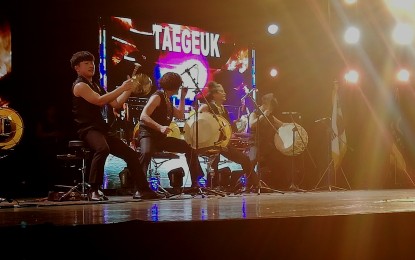
SAMULNORI. Korean traditional music known as “Samulnori”, which originated from the words "samul" (four objects) and "nori" (play), uses four traditional instruments: Kkwaenggwari (small gong), Jing (larger gong), Janggu (hourglass-shaped drum) and Buk (barrel drum). This Korean folk genre was one of the highlights of the Philippines-Korea Exchange Festival at the Aliw Theater in Pasay City on Saturday (Sept. 28, 2019). (PNA photo by Cristina Arayata)
MANILA -- Cultural exchanges enable countries to get a peek of each other's culture. These include showcasing arts, dance, and music.
At the recently concluded Philippines-Korea Exchange Festival, traditional Korean percussion music, Samulnori, was showcased. Who would have thought percussion instruments have a story to tell?
"Samul" (four objects) "nori" (play) uses four traditional instruments: Kkwaenggwari (small gong), Jing (larger gong), Janggu (hourglass-shaped drum) and Buk (barrel drum). This Korean folk genre is played with music, acrobatics, folk dance, and rituals.
The Taegeuk Samulnori Team from South Korea performed energetically during the festival on September 28. The Philippine News Agency (PNA) had an exclusive interview with the group's manager and member, Kim Do-geun.
Kim plays the Janggu, which is a Korean percussion instrument.
"In Janggu, there is (the) sound of Yin and Yang, which represent also earth and sky. So it can be said that we express the energy of earth and sky with this instrument," Kim said, adding that because Janggu consists of two heads made from animal skin, Koreans believe that it delivers the sound of all things in the universe.
He also noted that most percussion instruments are one-sided instruments. Janggu, on the other hand, have two sides that one needs to play differently.

"I think the manner of managing both sides (is important), considering their harmony. Sometimes it feels more difficult (to play Janggu) than other percussion instruments," he said.
Among the four instruments in Samulnori, Kim thinks that Janggu is the instrument that can represent his country.
It took him more than 20 years to learn and master Janggu. "I can say it is really hard to master (this)," he said.
Taegeuk was formed in 1998.

"It has been 20 years since we were formed. We all met from the same middle school in Chuncheon, the capital of Gangwon province in Korea. We were all interested in traditional Korean music, which is referred to as 'gugak', and we decided to run a team," he recalled.
According to him, he and the other members, Lee Jong-sub, Sim Jae-rang, Choi Young-soon, and Lee Kyu-tae, are more focused on powerful actions in their performances.
"Aside from the beautiful sound of Janggu and its flexibility, we show more power of the instrument, as well as showcase masculine performance full of energy," Kim said.
When it comes to learning "Garak" (beats, rhythms), Kim said the group can master it within a year.
"But to be accustomed to (the) basic style of batting and getting in sync all together, it takes a really long time," he noted.
Kim emphasized that Taegeuk works as a team, and thus, the members make music altogether.
"We need to be attuned with each other, considering each one's style. It may be hard sometimes, but it feels rewarding that we perform together," he said.

Kim also said playing Janggu with other artists makes him more fulfilled and more delighted. "(By) synchronizing each action, each rhythm, we form harmony. That is ineffable," he said.
It was Taegeuk's fourth time to visit the Philippines, and Kim said Filipinos have always been full of energy.
"Each time we performed, we felt really thankful as Filipinos are so welcoming and friendly. With that, I find that Filipinos embrace other cultures with open arms," he said.
More than 2,000 people gathered at the Aliw Theater in Pasay City for the festival.
The event serves as a platform for both countries to showcase talents and culture, said National Commission for Culture and the Arts (NCCA) Bernan Joseph Corpuz, Plan/Policy Formulation and Programming Division chief.
This year's festival, he said, was part of celebrating the 70th diplomatic relationship between the Philippines and South Korea.
Other performers included rising P-pop group SB19; Korean artists based in the Philippines JinHo Bae and Dasuri Choi; the Philippine Madrigal Singers; and Jean Kiley, 2014 K-pop Star Singing Category winner.
A fashion show was held in between concerts. Filipino textiles were featured in Ditta Sandico's works, while various Hanbok designed by Kim Yong-ae were also showcased.
The festival was hosted by the NCCA, United Korean Community Association, in partnership with the Embassy of Korea and the Korean Cultural Center. (PNA)
